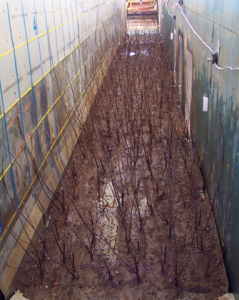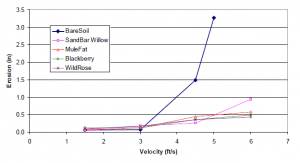Project Description:
Supported by the California Department of Water Resources, the main objectives of the study are to:
- determine the hydraulic roughness (Manning’s n) associated with sandbar willow, mule fat, blackberry and wild rose riparian plant species under various flow conditions (from low to high flows) in comparison with bare soil roughness conditions that may be present on the floodplains in river reaches where these plants occur;
- determine soil erosion/deposition under the plant canopy/bare soil riverbed;
- quantify the response of stems of the selected plant species under various flow conditions (from low to high flows).
The purpose of this study is to provide floodplain managers and engineers with information on the impact of native vegetations on flood flow hydraulics and information necessary to incorporate habitat concerns and benefits into the design and management of floodways and vegetated wetland habitats within the state of California. The study involved point velocity raw data measurements, hydraulic head measurements, soil erosion measurements, roughness coefficient estimations and characterization of plant canopy response to various flow regimes.
Hydraulics Experiment Configuration and Measurements:
At the time of this study, the Large Flume was configured with an 85 feet total flume length, 60 ft testing section, 8 ft high walls, and 5 ft interior width and pumping capacity of 75 cfs.
The following measurements were taken in each experiment:
- total discharge (ultrasound flow meter)
- velocity profiles at various locations (SonTek ADV 3-D Velocimeter)
- longitudinal hydraulic head profile (point gauges)
- water surface wave (digital floater)
- soil surface elevation (SonTek ADV) before and after run
- video of plant response for displacement analysis
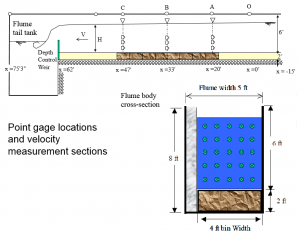
Longitudinal (top) cross-section view of the flume configuration, Cross-section view (bottom right) of velocity measurement locations.
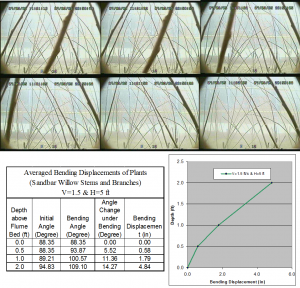
Viewing camera observation for analysis of plant bending, possible failure, and possible soil movement corresponding to each of the flow regimes.
The results of this experimental study indicate that the Manning’s roughness coefficient for native plant canopies is a function of the plant characteristics (i.e. plant species and time of the year), and the Reynolds number (i.e. flow velocity and flow depth). This result is quite different from the common engineering practice in the hydraulic computations where the Manning’s roughness is taken as a constant that does not change with flow velocity or flow depth. The resistance of any of the tested native California plant canopies (sandbar willow or mule fat or blackberry or rose) to flow discharge (in terms of the Reynolds number) actually decreases as flow velocity and flow depth increase toward flood flow conditions. This is due to the dynamic process whereby the plant leaves and stems adopt to a more streamlined position as water pushes against them. Such streamlining can decrease the resistance to flow, generated by a plant, by more than a halve. For example, the Manning’s n for Wildrose#1(Jun) canopy has changed from 0.127 to 0.026 (about 80% reduction) as the Reynolds number increased from 75000 to 496000. On the other hand, the roughness coefficient for the bare soil surface increases slightly as the Reynolds number increases.
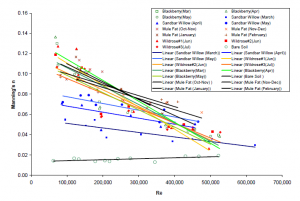
Manning’s n plotted against Reynolds number for bare soil, and a variety of plant species at different seasonal conditions.
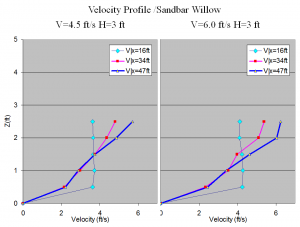
Velocity Profile in flume for Sandbar Willow in two hydraulic scenarios. The velocity profile is measured both in front of, and within, the vegetated section ( x = 17 to 49), showing that velocities increase with depth in the vegetated section.

